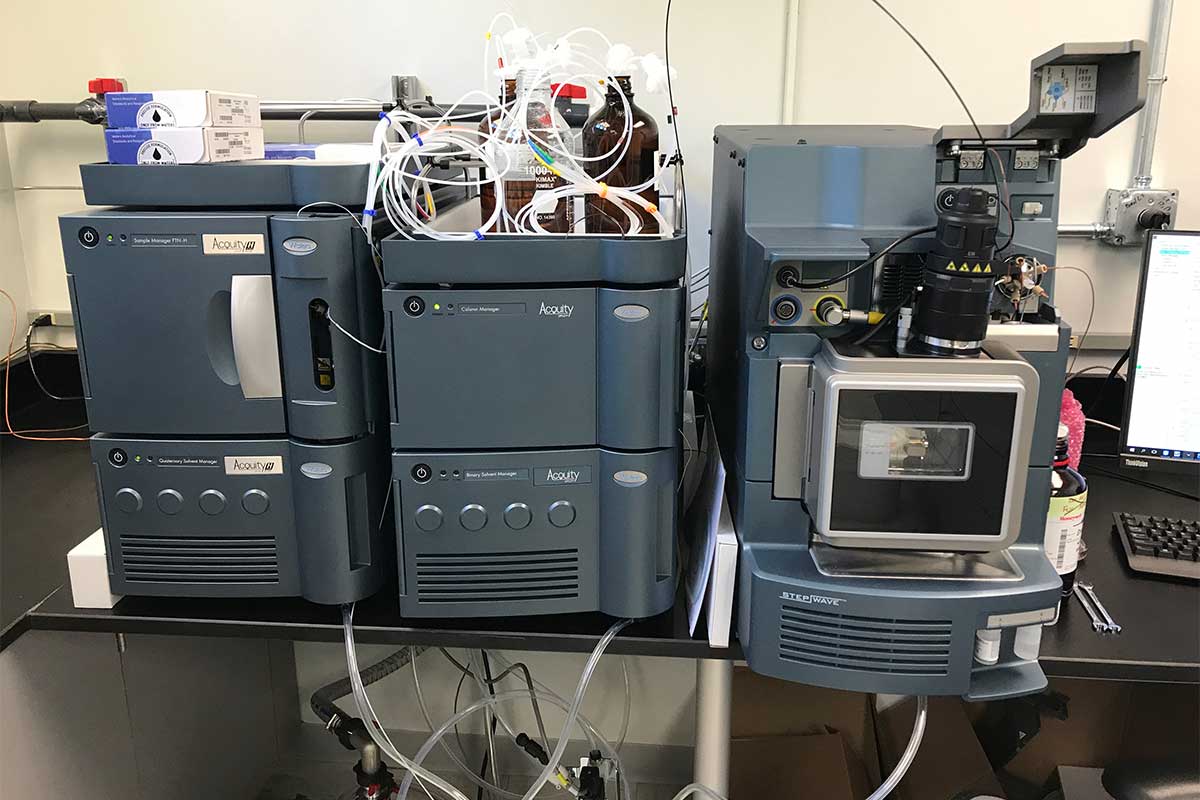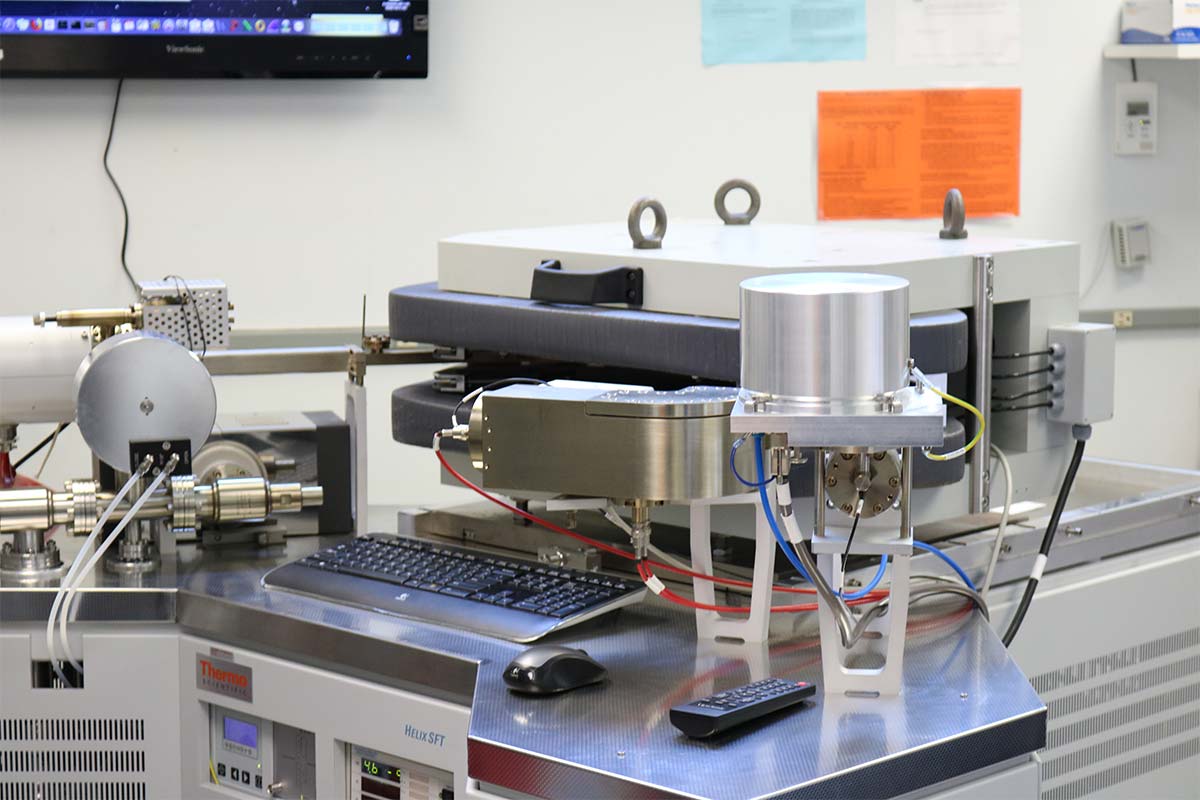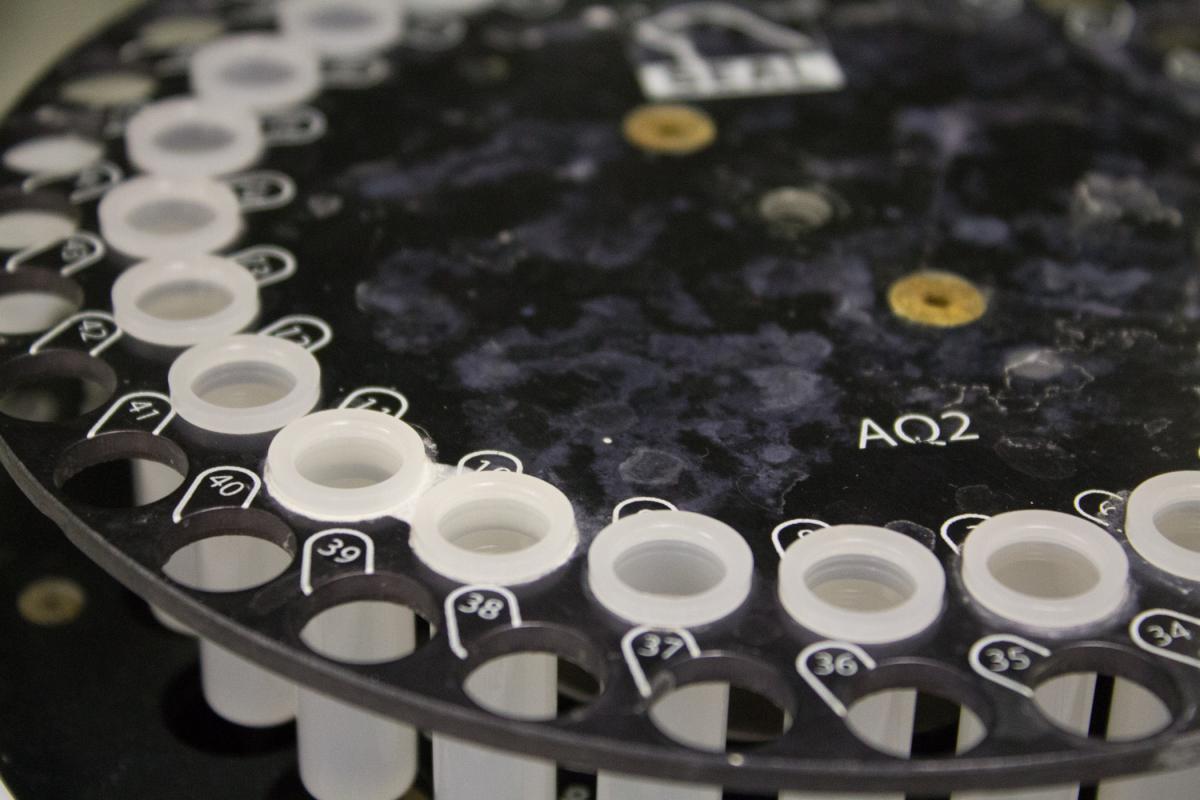Specialized instrumentation for environmental monitoring
The Water Sciences Laboratory is a 6,000 square-foot facility located at the University of Nebraska-Lincoln's East Campus. The building consists of six laboratories dedicated to environmental mass spectrometry , stable isotope and noble gas analyses, and standard analytical methods for water quality each with instrumentation dedicated to specialized protocols. Read more about the dedicated instrumentation for our analytical methods below.
Learn more about the water sciences laboratory
Acknowledgement Text
Agencies (including the National Science Foundation) and the University of Nebraska providing partial support for the Nebraska Water Sciences Laboratory request that the following words be included in any Acknowledgement section of a paper using methods and services from our facilities:
“Part of this research was performed in the Nebraska Water Sciences Laboratory, part of the Nebraska Water Center and Daugherty Water for Food Global Institute. “

Environmental Mass Spectrometry and Chromatography
Mass spectrometry is the most widely used analytical tool for environmental analyses due to its sensitivity, reliability, and versatility. Instrumentation in the Water Sciences Laboratory is used for developing and applying methods to accurately measure very low concentrations of organic contaminants such as per-and polyfluoroalkyl substances (PFAS), pesticides, munitions residues, steroids, mycotoxins, antibiotics, pharmaceuticals, algal toxins, gasoline additives, and degradation products in a wide variety of matrices. Additional methods include measurement of various species of arsenic, selenium and iron, and glyphosate and its metabolites.
New methods have been developed in this facility using state-of-the-art instrumentation for analysis of these and other emerging contaminants.
Dedicated Instrumentation
- Waters Xevo TQS micro with 2D Acquity UPLC: A state-of-the-art ultrahigh pressure liquid chromatography-triple quadrupole mass spectrometer (UPLC-MS/MS) capable of highly sensitive and selective analysis of polar (water soluble) organic contaminants. Options include electrospray (ESI), atmospheric pressure photoionization (APPI), atmospheric pressure chemical ionization (APCI), and Uni-SprayTM ion sources. The 2-dimensional “2D” UPLC supports high resolution rapid separation and ability for online sample extraction. Short run times, improved ion optics and rapid scan times support new robust multiresidue methods. This instrument offers unmatched capabilities for emerging organic contaminant detection.
- Waters Xevo TQS micro with Acquity H-Class UPLC: This second instrument uses the same sources and provides redundancy for parallel and high throughput analysis of emerging contaminants.
- Thermo Scientific iCAP RQ inductively coupled plasma-mass spectrometer (ICP-MS): A powerful instrument capable of measuring trace levels of both metals and metalloids in a wide variety of matrices. Its comprehensive interference removal assures data accuracy, while its innovative helium Kinetic Energy Discrimination (He KED) technology enables measurement of analytes in a single mode. This versatile instrument maximizes productivity and robustness with high sensitivity. Options include a Themo Dionex IC 5000+ ion chromatography interface for determination of metal species and polar pesticides such as glyphosate and its metabolites.
- Agilent 5973 gas chromatograph/mass spectrometer (GC/MS): A GC/MS with both electron and chemical ionization sources, and a newly designed inert source that improves sensitivity by magnitude. A Leap CombiPAL autosampler permits automated headspace and solid phase microextraction in addition to the traditional liquid solvent injection of samples. This instrument is used for gasoline oxygenate analysis, along with methods for volatile organics and pesticides. Options include an OI Eclipse purge and trap autosampler for analysis of volatile organics.
- Hewlett Packard 5972 Gas chromatograph/mass spectrometer (GC/MS): This instrument is used for analysis of volatile and semi-volatile compounds.
- Waters Alliance 2695 HPLC with photodiode array and fluorescence detection: This HPLC is primarily used for the detection of pigments, and methods that don’t require the sensitivity of a mass spectrometer.

Stable Isotope + Noble Gas Mass Spectrometry
Elements often have different atomic forms or masses (i.e. isotopes), that vary in abundance. Stable isotope analysis focuses on high precision measurements of naturally occurring isotopes of hydrogen, carbon, nitrogen, and oxygen. Natural variations of the abundance of these isotopes can help discover the origin and flow of these elements in the environment. Stable isotope analysis often “fingerprints” sources of contaminants such as nitrate and can also be used in studying chemical reactions and metabolic processes. The WSL offers methods for stable isotope analysis of gases, water, and solids. The lab is well known for its methods for determination of the isotopic composition of nitrate and ammonia nitrogen to support the investigation of nitrate contamination of groundwater and environmental fate and transportation. The newest capability is compound specific isotope analysis.
Dedicated Instrumentation
- Elementar visION Compound-Specific Isotope Analyzer (CSIA): A state-of-the-art instrument which allows for high precision measurement of hydrogen, carbon, nitrogen, and oxygen isotopes in volatile and semi-volatile compounds. Components include a vario PYRO cube for high temperature pyrolysis, an Agilent 8890 gas chromatograph coupled to a GC5 combustion furnace, and an Isoprime visION stable isotope mass spectrometer.
- AP2003 with Isoprep: A continuous flow isotope ratio mass spectrometer with a computer-controlled system enabling automated preparation and analysis of water and gas samples for carbon-13 and oxygen-18 analysis. The AP2003 has been retrofitted with a Carlo Erba NA1500 elemental analyzer that permits routine analysis of 13C in solid samples (plant tissue and soil), as well as low-cost analysis of carbon and nitrogen content.
- GV Isoprime continuous flow mass spectrometer with a Eurovector solids elemental analyzer: Allows for high precision analysis of carbon and nitrogen isotopes in solids (plants, salts, sediments).
- GV Isoprime dual inlet isotope ratio mass spectrometer: An instrument well suited to small sample stable isotope analysis and is used for both nitrogen and carbonate stable isotope analysis where high sensitivity is required. The GV Isoprime is retrofitted with a GVI Trace Gas cryogenic preconcentrator for automated isotope analysis of nitrous oxide and methane and is frequently used for nitrate isotope determination.
- Picarro cavity ring-down spectrometer (CRDS): For analysis of deuterium and oxygen isotopes in water.
- Trace Analytical reduced gas analyzer RGA3: For analysis of hydrogen and carbon monoxide in air and water.
- Helix SFT noble gas mass spectrometer and extraction system: A custom-built, automated, and ultrahigh vacuum system where noble gases (helium-3, helium-4, neon, argon, krypton, and neon) and nitrogen are quantitatively extracted from water samples collected in sealed copper tubes. Gases are cryogenically separated using two ultralow temperature traps (10- and 24-degrees Kelvin) and subsequently quantified on a Thermo Helix SFT noble gas mass spectrometer, Hiden RCF 1.2 quadrupole mass spectrometer, and MKS capacitance manometers. The system is also capable of determining low level tritium (3H) activity in water by ingrowth. The system is dedicated to age dating young groundwater following the tritium/helium-3 method and is based on the system design described in Stanley et al. (2009). The WSL provides sampling copper tubes and equipment needed to properly collect and preserve samples for age dating as described in Aeschbach-Hertig and Solomon (2013) as part of the service fee.

Dedicated Instrumentation
- Seal AQ400 discrete autoanalyzer: A compact bench-top instrument used for rapid and precise colorimetric analysis of ammonia, nitrate, phosphorus, silica, and other water quality parameters.
- Seal AA500 segmented flow autoanalyzer: Used for high throughput and low-cost nutrient (nitrate and ammonia) analysis in soil/sediment extracts.
- OI Analytical 1030W organic carbon analyzer: Used for automated low-level analysis of dissolved organic carbon in water.
- Thermo Dionex ICS 5000+ ion chromatography system: Used primarily for major ions and can be configured for detection of a wide range of inorganic and organic species in water. Components include an AS-AP autosampler, conductivity, ultraviolet and fluorescence detectors and a gradient pump.
- Agilent 720 inductively coupled plasma optical emission spectrophotometer (ICP-OES) with axial plasma source and SPS 3 autosampler: Used for automated analysis of metals and trace elements such as sodium, potassium, calcium, iron, copper, lead, chromium and zinc. Capable of simultaneous detection of multiple elements at parts per million levels in aqueous samples.
- Labconco RapidVap Concentrator and Organomation 34 position N-EVAP nitrogen evaporator: Used for evaporating solvent extracts.
- CEM MARS XPress microwave digester/extraction system: Performs acid digestions and solvent extractions.
